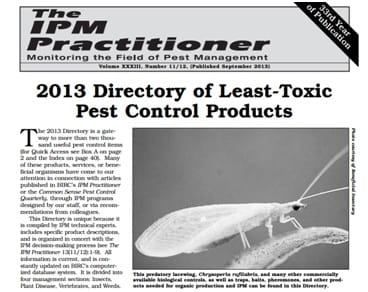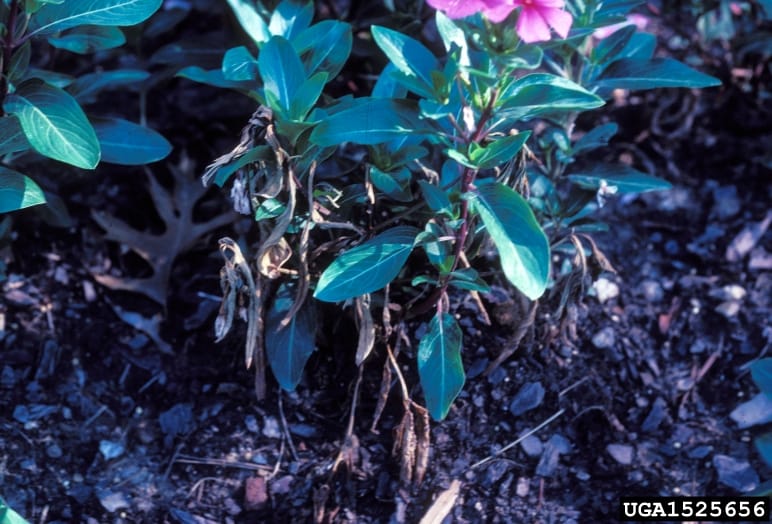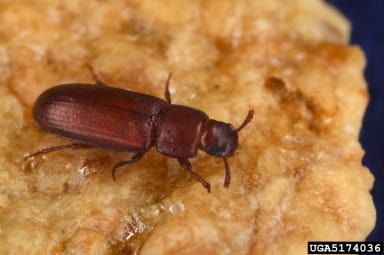Pest Control Alerts give the Georgia pest control industry current info from UGA and related university partners. On this Popular Press Articles page, we include articles of interest from media or others outside the university community. Since these come from writers outside UGA, we cannot vouch for all the info and the views expressed do not reflect the opinion of UGA or its partners. We merely include these here for your interest.
Month: November 2013
Brown Recluse Spider isn’t Typically a Southerner
Sharon Dowdy, News Editor with the University of Georgia College of Agricultural and Environmental Sciences
A University of Georgia researcher says brown recluse spiders in Georgia are being wrongly blamed for wounds they don’t cause.
“Most of the state of Georgia doesn’t even have brown recluse spiders,” said Nancy Hinkle, an entomologist with the UGA College of Agricultural and Environmental Sciences. “If the spiders in the state caused all the wounds that are reported as brown recluse bites, they would be some very busy spiders.”
The Brown Recluse is not a Southerner
From 2001 to 2007, Hinkle tracked verified findings of brown recluse spiders in Georgia. The study was prompted by Hinkle’s arrival from California.
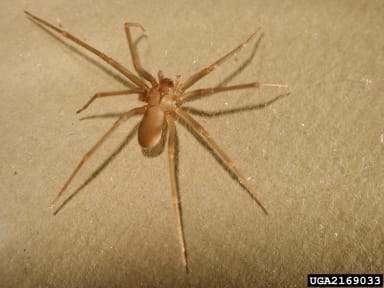
“When I first came to Georgia, I heard several people say they knew someone who’d seen or been seriously wounded by a recluse,” she said. “I found that odd since the recluse is a Midwesterner, not a Southerner.”
The brown recluse is mostly brown but has a darker, violin-shaped design where its legs attach. With its legs extended, it’s only about the size of a quarter.
Hinkle has received hundreds of spider samples from Georgians all across the state. Rick Vetter from the University of California at Riverside identifies the samples. He is the world’s expert on brown recluse spiders.
Only Two out of Twenty-five are Recluse Spiders
Lisa Ames with the UGA CAES Homeowner Insect and Weed Diagnostic Laboratory in Griffin also collects spider samples submitted by homeowners and pest control companies. In 2003, 2004 and 2005 she received an average of 25 samples each year. Only two samples annually were recluses.
Through 2007, the UGA scientists had collected only 14 verified brown recluse spiders. And they had confirmed the spider in just 26 of Georgia’s 159 counties, mostly in the northwest.
“Another reason for doing this study is to help the medical community rule out brown recluse bites from portions of the state that don’t have the spiders,” Hinkle said. “A diagnosis of a brown recluse bite in Savannah is highly questionable.”
Most Likely not Spider Bites
Hinkle hopes the study will educate Georgia’s medical community and reduce the number of erroneous recluse bite cases. A mark on the skin that looks like a spider bite could be something much more serious.
She believes many assumed brown recluse bites could be methicillin-resistant Staphylococcus aureus. MRSA is a type of staph infection that’s resistant to antibiotics like penicillin, amoxicillin and oxacillin. MRSA causes mild skin infections which result in pimples or boils. But it can also cause more serious skin lesions or infect surgical wounds.
MRSA and Brown Recluse Wounds can Look Similar
“Over the past five to 10 years, the number of MRSA cases has exploded,” Hinkle said. A MRSA infection can look like a brown recluse wound.
A brown recluse spider’s bite often isn’t the painful part of the experience. The spider’s venom destroys the tissue at the bite site. Several hours later, a blister-like sore appears and grows. It can become as small as a pin to 8 inches across.
Almost all brown recluse bites heal nicely without medical intervention, Vetter said. And in spite of all the horror stories, only 3 percent require skin grafts.
Incorrectly diagnosing MRSA as a spider bite, and vice versa, can result in a patient getting the wrong therapy, Hinkle said. “The required treatment for a brown recluse bite is totally different from the treatment needed for MRSA,” she said. “Common antibiotics don’t touch MRSA. And you obviously wouldn’t need to spray insecticides when you aren’t dealing with a spider problem.”
Peaceful Co-exsisters
Brown recluse spiders aren’t vicious and are not looking to bite people, Vetter said. A Kansas family collected more than 2,000 brown recluses from their home in six months. “They’ve been living there for eight years and still have shown no evidence of a single bite,” he said. “People tend to overreact and believe the worst.”
For more information:
Why You Need Not Fear the Poor, Misunderstood Brown Recluse Spider
IPM directory of least-toxic products available
Article taken from Southern Region IPM News
(Editor’s note – this guide lists low toxicity alternatives for pest control. It does not mention the effectiveness of each option. This can be a starting point for finding low toxicity options for pest control but more research will be needed to determine the efficacy of each option. WC)
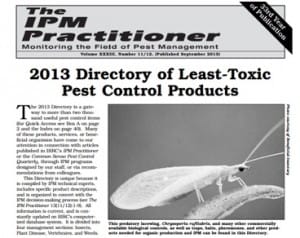 The IPM Practitioner’s 2013 Directory of Least-Toxic Pest Control Products is now available online. This Directory lists more than 2,000 products such as baits, traps, pheromones, microbials, biocontrol agents, and other materials needed for IPM.
The IPM Practitioner’s 2013 Directory of Least-Toxic Pest Control Products is now available online. This Directory lists more than 2,000 products such as baits, traps, pheromones, microbials, biocontrol agents, and other materials needed for IPM.
Contact information is provided for more than 600 national and international suppliers. The Directory can be found at the following link:
http://www.birc.org/Directory.htm
And take a look at the October 11 post in Insects in the City for a little more information about the directory and its publisher.
Get the most from your pansies!
By now, most pansies are in the ground. Now it is time for winter care to improve their performance! UGA Extension has an excellent publication on growing pansies – Success with Pansies in the Winter Landscape: A Guide for Landscape Professionals. It provides info and the practices that help us get the most from our pansies.
 Here are some examples of info from this publication. Did you know?
Here are some examples of info from this publication. Did you know?
- Once the weather cools and soil temperatures drop below 60° F, pansies grow better when fed a liquid feed program using a fertilizer containing at least 50 percent of its nitrogen in the nitrate form.
- Fertilizers containing more ammonia can be used more once soils warm in the spring – starting about March 15.
- Reduce fertilization during warm weather to control plant growth.
- Pansies grow best in soils with a pH of 5.4 – 5.8. Higher pH encourages boron and iron deficiencies while making plants more susceptible to black root rot.
- Removing frost-damaged and old and faded flowers improves the looks of the bed, encourages more flowering and can reduce disease incidence.
- You can trim lanky branches to produce stocky plants with more branches and flowers.
Several insects and diseases affect pansies. For help identifying these problems, contact your local Extension Office.
For more information, see the entire publication here.
New fungicides for ornamental disease control
Jean Williams-Woodward, UGA Extension Plant Pathologist
Several fungicides for ornamental production have come on the market within the past couple of years. Below is a summary of some of the products.
Many of the products control Oomycete diseases including downy mildews and Pythium and Phytophthora root rot and blights. This is great news since there were few good Oomycete fungicide options available previously other than Subdue MAXX, Aliette and the numerous phosphonates/phosphites. Oomycete pathogens develop fungicide resistance readily.
Current research on Phytophthora and Pythium populations within GA nurseries and greenhouses has shown that approximately 5-25% of the isolates from individual production facilities are resistance to mefenoxam (Subdue MAXX). To reduce fungicide resistance development, always use products according to label rates and restrictions and rotate applications with products with a different mode of action (i.e. different FRAC numerical code).
| Brand Name | Active Ingredient | FRAC # | Sites1 | Diseases Controlled |
| Adorn | Fluopicolide | 43 | G, L, N | Downy mildew, Phytophthora, Pythium: Must be tank mixed with a product with a different mode of action (different FRAC #) for fungicide resistance management |
| Disarm O | Fluoxastrobin | 11 | G, N | Broad spectrum – Rhizoctonia, Phytophthora, downy mildew, powdery mildew, anthracnose, leaf rusts, various fungal leaf spots and blights |
| Micora | Mandipropamid | 40 | G, N | Downy mildew and Phytophthora foliar blight and root rot: Provides a good rotation partner to Subdue MAXX, Segway and Adorn. |
| Orvego | Ametoctradin + dimethomorph | 45 + 40 | G, N | Downy mildew and Phytophthora: Contains the same active ingredient as Stature fungicide. Use in rotation with products with different mode of action. |
| Pageant | Boscalid + Pyraclostrobin | 7 + 11 | G, L, N | Broad spectrum – Anthracnose, powdery mildew, various fungal leaf spots, Botrytis, downy mildew, Phytophthora, Rhizoctonia, Cylindrocladium |
| Palladium | Cyprodinil + Fludioxonil | 9 + 12 | G,L, N | Provides good Botrytis control, plus other diseases including Rhizoctonia, powdery mildew, Cylindrocladium, Sclerotinia, Sclerotium rolfsii, Fusarium, certain fungal leaf spots |
| Segway | Cyazofamid | 21 | G, L, N | Downy mildew, Phytophthora, Pythium. |
| Torque | Tebuconazole | 3 | G, L, N | DMI fungicide with same mode of action as Strike, Banner MAXX, and Systhane. Controls powdery mildew, rusts, Sclerotium rolfsii, black spot, and various other fungal leaf spot diseases. |
| Tourney | Metconazole | 3 | L, N | For use on woody ornamentals (not floriculture). DMI fungicide. Controls anthracnose, powdery mildew, rusts. |
| Trinity TR | Triticonazole | 3 | G, L, N | Supplemental labeling for use on ornamentals. DMI fungicide. Controls anthracnose, powdery mildew, Fusarium, Rhizoctonia, Sclerotium rolfsii, Sclerotinia, certain fungal leaf spots |
| Veranda O, Affirm | Polyoxin D | 19 | G, N | Botrytis, Colletotrichum, Alternaria, Fusarium, Rhizoctonia, Sclerotinia |
1 Location where product is registered for use: Greenhouse (G), Landscape (L), Nursery (N)
Better Trap on Tap for Red Flour Beetle Control
Source – Jan Suszkiw in the Southern Region IPM News
Better control of red flour beetles and other costly stored-product insect pests could be on hand, thanks to a new pitfall trap designed by U.S. Department of Agriculture (USDA) researchers.
According to chemist Peter Teal with USDA’s Agricultural Research Service (ARS), the commercial traps now used are typically dome-shaped devices baited with pheromones or other attractants that lure the beetles into pits or onto glue strips. However, the new design, named the “Terrestrial Arthropod Trap,” takes this “fatal attraction” to a new level, adds Teal, who leads the Chemistry Research Unit at the ARS Center for Medical, Agricultural and Veterinary Entomology in Gainesville, Fla.
He co-developed the technology with Lee Cohnstaedt of the ARSCenter for Grain and Animal Health Research in Manhattan, Kan., and Adrian Duehl and Richard Arbogast, both formerly with ARS at Gainesville.
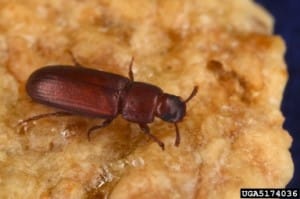
The red flour beetle, Tribolium castaneum, is a primary target of the team’s trap design research because the pest eats both raw and processed cereal grains. It commonly infests flour mills, but can also be found in warehouses, storage bins and household food pantries, causing millions of dollars in losses annually.
Among its features, the new trap is pyramid-shaped and sports slender fins that coax inquisitive beetles into a central pit where they can be captured. The trap is also fitted with light-emitting diodes (LEDs) whose colored light—set to wavelengths of 390 nanometers (nm)—attracts beetles from long distances, ensuring they get a whiff of pheromone as they approach.
In laboratory trials, red flour beetles visited LED traps set to 390 nm approximately 16 times versus two to five times for traps set to other wavelengths. Moreover, the team determined, positioning the LEDs at the trap’s top captured more beetles (approximately 55 total) than placing the diodes at the bottom (12 captured). Combining the LEDs with attractant made the pyramid design even more effective, capturing 70 beetles versus four using a standard dome design.
Read more about this ARS-patented technology in the October 2013 issue of Agricultural Research magazine.

